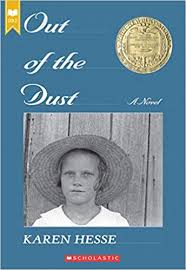Novel Poems
Listen to the Recess! Clip
| Author | Kevin Shortsleeve |
| Air Date | 4/5/2002 |

Novel Poems Transcript
Several years ago, if you handed a ten year old child a seven hundred page novel and asked him or her to read it – one would likely have met with an expression of sorrow and woe. But with the advent of Harry Potter, all that has now changed now – and with the recent success of several novels-in-poems for young readers, we would seem to be entering an age of increased sophistication on the part of the child reader.
Virginia Euwer Wolff’s Make Lemonade, and Karen Hesse’s Out of the Dust are both novels for children told in poetry. Hesse’s Out of the Dust is an especially arresting book. Winner of the prestigious Newbery Medal for children’s literature, Out of the Dust is a 227 page novel comprised of 111 free verse poems. Hesse tells the story of Billie Jo, an adolescent girl coming of age amid tragedy and triumph in 1930’s dustbowl-America. What is perhaps most amazing about this book is that if you open it up at random, and read any page, the poem you are looking at feels complete – a self contained work on its own. But if you read each poem in order from front to back, the book tells a seamless tale – complete with traditional narrative devices such as character development, tension, and resolution.
Other books like Paul Fleishman’s Joyful Noise, Poems for Two Voices and Sharon Creeche’s Love That Dog, also embrace alternative poetic verse structures – and have been successful with children and critics alike.
With such sophisticated approaches to books for children gaining acceptance, an old debate about genre studies emerges. There are some who believe that there should be no difference between children’s literature and adult literature. Such critics would claim that there should simply be good books – period – with out all the classifying of who, precisely, certain titles are appropriate for. And it is true, for example, that with folk tales and fairy tales, the original stories were meant to entertain audiences of all ages. And indeed, it is only somewhat recently that fairy tales, were confined to the children’s bookshelf.
Regardless of that debate, there is something heartening in the simple fact that children today are regularly adapting to new, challenging and alternate forms of literature. With 700 page novels and novels in poems now reaching young readers, it seems clear that, despite competition from the Internet, video games and whatever other technical innovation science may distract them with – children are still turning to books – and in more sophisticated ways than ever